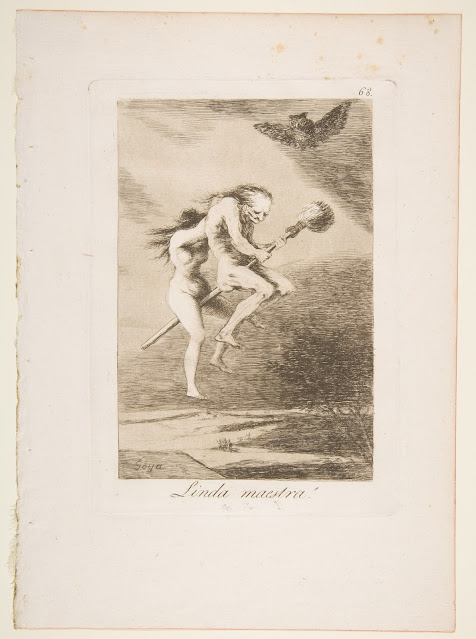Pretty Teacher! (Linda maestra!) by Francisco Goya (Interpretation and Analysis)
 |
| Linda maestra! Source: Metropolitan Museum of Art |
Goya’s print series Los Caprichos, published in 1799, is widely considered to be one the most influential artistic projects of its time. The Caprichos were not widely known at the time of their publication, but they had a resounding impact on art over the next hundred years. Although the Caprichos series explores themes of the Enlightenment—which is usually associated with logic and reason—many of the prints are incredibly dark, full of violence, chaos, and black magic. Thus, they’re perfect for Spooky Season (a.k.a. October).
Two of the major themes in Los Caprichos are prostitution and witchcraft, both of which are closely related to the way Goya viewed social ills in contemporary Spanish society. These themes are explored in print number sixty-eight: Linda maestra! (Pretty Teacher!). The piece depicts two naked women riding on a flying broomstick. The older woman, who can be identified as the titular teacher, is directing the broom, while the younger one clings to her. An owl flaps through the sky behind them, a reference to a contemporary Spanish slang term for prostitutes.
Ostensibly, Linda maestra! depicts an older witch initiating a younger woman into her magical rituals. For Goya, witches functioned as a symbol in his art. In his work, they represent the backwards social customs and superstition that plagued Spain at the time. Goya believed that Spain was being held back by a dogmatic adherence to medieval beliefs and superstition, which he subtly mocks in his witch paintings. The inclusion of witches in his art can also be read as a criticism of the Spanish Inquisition, which continued to seek and punish witches well into the seventeenth century. The overall theme of these witch paintings is the struggle between the ultra-religious, royalist state and the newfound trend toward liberalism and secularization.
As I noted above, Linda maestra! also makes reference to prostitution. Throughout Los Caprichos, Goya explores different types of relationships between men and women and gender more generally. There are several prints in the series that show sex workers in various contexts, but the most interesting images depict older women initiating younger women into their profession. It is nicely stretched (Bien tirada está) and Ruega por ella (She prays for her) are the two most prominent examples of these prints.
Taken in this context, Linda maestra! can be seen as a social commentary that recognizes the role that tradition has in perpetuating destructive societal patterns. In the case of Bien tirada está and Ruega por ella, we see older women continuing the cycles that they themselves have been victims of. It’s a tragic situation that Goya draws attention to through his satirical use of witches.



Comments
Post a Comment